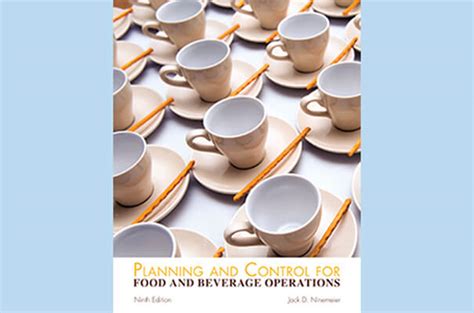Planning and Control for Food and Beverage Operations: A Comprehensive Guide
Running a successful food and beverage (F&B) operation requires more than just delicious recipes and friendly staff. Effective planning and control are the cornerstones of profitability and sustained growth. This comprehensive guide dives into the key aspects of planning and controlling your F&B business, from forecasting demand to managing costs.
I. Forecasting Demand: The Foundation of Your Plan
Accurate forecasting is crucial. It allows you to:
- Optimize inventory: Avoid food waste and spoilage by ordering the right amount of supplies.
- Staff effectively: Ensure you have the right number of employees during peak and off-peak hours.
- Manage costs: Control expenses by aligning your resources with predicted demand.
Methods for forecasting:
- Historical data analysis: Analyze sales data from previous periods (daily, weekly, monthly, annually) to identify trends and patterns. Consider seasonality and special events.
- Market research: Understand your target audience and their preferences. Conduct surveys, analyze competitor offerings, and monitor industry trends.
- Sales promotions: Account for anticipated changes in demand driven by marketing campaigns and promotions.
Pro Tip: Use forecasting software to streamline the process and improve accuracy. Consider factors beyond historical data, like upcoming events in your area or changes in local demographics.
II. Menu Engineering: Maximizing Profitability
Your menu is a powerful tool. Menu engineering involves analyzing the profitability and popularity of each menu item to make informed decisions about pricing, promotions, and menu composition.
Key metrics to consider:
- Contribution margin: The difference between the selling price and the cost of goods sold (COGS) for each item.
- Popularity: How often each item is ordered.
- Menu item classification: Categorize items into four quadrants (stars, plowhorses, puzzles, dogs) based on their contribution margin and popularity.
Strategies based on menu item classification:
- Stars: High profitability and popularity – maintain and promote these items.
- Plowhorses: High popularity but low profitability – consider increasing prices or reducing COGS.
- Puzzles: Low popularity but high profitability – promote these items more effectively.
- Dogs: Low profitability and popularity – remove these items from the menu.
III. Inventory Management: Controlling Costs and Minimizing Waste
Efficient inventory management is vital for controlling costs and minimizing waste. Implementing a robust system involves:
- Regular stocktaking: Conduct regular physical inventory counts to verify stock levels and identify discrepancies.
- First-In, First-Out (FIFO): Utilize the FIFO method to ensure older items are used before newer ones, minimizing spoilage.
- Inventory control software: Use software to track inventory levels, automate ordering, and generate reports.
- Minimizing waste: Implement strategies to reduce food waste, such as proper storage, portion control, and creative menu planning using leftover ingredients.
IV. Cost Control: Monitoring Expenses and Maintaining Profitability
Effective cost control requires monitoring all aspects of your operations:
- Food cost: Track the cost of ingredients and identify areas for reduction. Negotiate better prices with suppliers.
- Labor cost: Optimize staffing levels, schedule employees efficiently, and provide adequate training.
- Operating costs: Monitor utilities, rent, and other operating expenses. Identify areas for cost reduction without compromising quality.
V. Performance Monitoring and Evaluation: Continuous Improvement
Regularly monitor your key performance indicators (KPIs) to assess the effectiveness of your planning and control strategies. Some important KPIs include:
- Food cost percentage: The ratio of food cost to revenue.
- Labor cost percentage: The ratio of labor cost to revenue.
- Customer satisfaction: Collect feedback through surveys and reviews.
- Inventory turnover: The rate at which inventory is sold and replenished.
Use this data to make adjustments and continually improve your operations.
By implementing these planning and control strategies, you can build a strong foundation for a successful and profitable food and beverage operation. Remember that continuous monitoring, adaptation, and improvement are key to long-term success.
